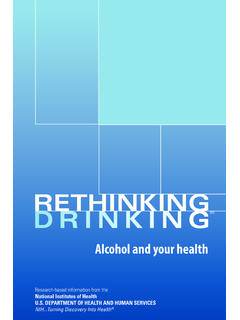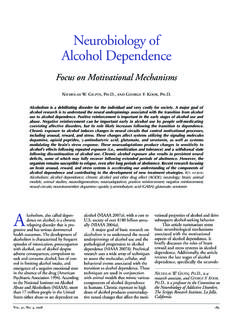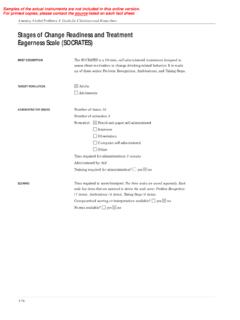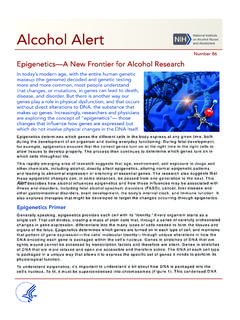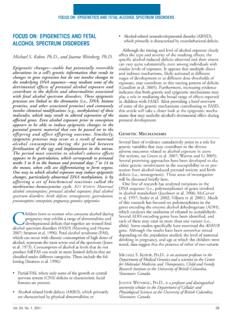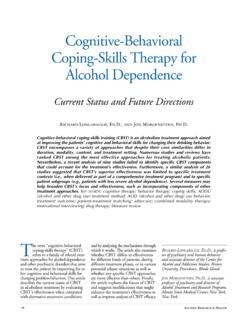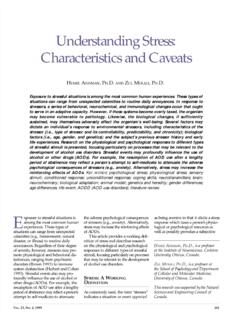Transcription of The Neurobiology of Addiction - National Institutes of …
1 VOL. 21, NO. 2, 1997101 Addiction can be defined from abehavioral viewpoint as repeat-ed self-administration of alco-hol or other drugs (AOD s) despiteknowledge of adverse medical andsocial consequences and attempts toabstain from AOD use. Typically, anaddicted person s daily activities arecentered on obtaining and consumingthe drug at the expense of social andoccupational commitments. Manyfactors contribute to the developmentof Addiction . A person s initial deci-sion to use a drug is influenced bygenetic, psychosocial, and environ-mental factors. Once it has entered thebody, however, the drug can promotecontinued drug-seeking behavior byacting directly on the over the past two decadeshas increased our understanding of theneural processes that underlie drug-seeking behavior. This article summa-rizes some of the molecular andcellular events in the brain that appearto be associated with Addiction .
2 Thearticle first discusses some observablemanifestations of Addiction and basicmechanisms involved in initiating andmaintaining addictive behavior. Thehypothesized roles of various chemicalcommunication systems of the brain( , neurotransmitters and receptors)are explored, followed by a discussionof the interactions between these sys-tems within brain regions thought tobe involved in Addiction . Finally, the article discusses thesuggested role of an integrated systemof neural connections involving sev-eral adjacent brain regions. This arti-cle is not an exhaustive overview, buta sampling of some topics of interestto researchers studying Neurobiology ofAddictionAn Overview AMANDAJ. ROBERTS, , ANDGEORGEF. KOOB, can be defined in part as a compulsion to use alcohol or other drugs andthe occurrence of withdrawal symptoms when long-term consumption ceases.
3 Inaddition to physical symptoms related to nervous system hyperexcitability,withdrawal includes changes in mental state that may motivate renewed AODconsumption. The manifestations of Addiction are associated with changes in nervecell function by which the brain attempts to adapt to a drug s presence. Thesefunctional changes modulate a person s initial response to a drug, the establishmentof long-term craving for the drug ( , Addiction ), and the persistent sense ofdiscomfort that leads to relapse after abstinence has been achieved. Research isbeginning to reveal how specific brain regions may be integrated to form neuralcircuits that modulate aspects of Addiction . KEY WORDS: AOD dependence; compulsion;AOD withdrawal syndrome; AOD craving; positive reinforcement; AODD (alcohol and otherdrug disorders) relapse; AOD abstinence; neurobiological theory; neurotransmitters;neurotransmission; AOD sensitivity; biological adaptation; brain; dopamine; nucleusaccumbens; literature reviewAMANDAJ.
4 ROBERTS, , is aresearch associate in the Departmentof Neuropharmacology, The ScrippsResearch institute , La Jolla, KOOB, , is aprofessor and director of the Divisionof Psychopharmacology, Departmentof Neuropharmacology, The ScrippsResearch institute , La Jolla, Califor-nia, and adjunct professor in theDepartments of Psychology andPsychiatry, University of Diego, characteristics are common tomost definitions of AOD Addiction : thecompulsion to use a drug, leading to itsexcessive and uncontrolled consump-tion, and the appearance of a cluster ofsymptoms when the drug is withheldafter a period of its continuous con-sumption ( , withdrawal syndrome).Physiological symptoms of alcoholwithdrawal begin from 6 to 48 hoursafter the last drink and include tremors,elevated blood pressure, increasedheart rate, and seizures.
5 AOD with-drawal also includes changes in mentalstate ( , anxiety, negative emotionalstate, and craving) that may motivaterenewed AOD consumption. Thesesigns may both precede and outlast thephysiological symptoms. For the pur-pose of this article, Addiction is definedas a loss of control over AOD use andthe appearance of a withdrawal syn-drome with motivational aspects upon cessation of such factors that modulate behav-ior reinforcement and neuroadapta-tion contribute to the addictiveprocess. Reinforcement is a theoreticalconstruct by which a stimulus ( , anunconditioned stimulus, such as thedrug itself or drug withdrawal, or aconditioned stimulus, such as drug-taking paraphernalia) increases theprobability of a response ( , contin-ued use of the drug). Neuroadaptationrefers largely to the processes by whichinitial drug effects are either enhanced( , sensitization) or attenuated ( ,counteradaptation) by repeated AODexposure.
6 Drug-related responses ( ,reinforcement) are modulated by theneuroadaptive changes that occur withAOD exposure. Working together,these factors appear to motivate theinitial, short-term ( , acute) responseto a drug and the establishment of thelong-term ( , chronic) craving for thedrug that characterizes Addiction . Inaddition, some neuroadaptive changesmay be permanent, producing thepersistent sense of discomfort duringabstinence that leads to reinstatementof drug use ( , relapse).ReinforcementSeveral sources of reinforcement maycontribute to Addiction . In positivereinforcement, a rewarding stimulus( , AOD-induced euphoria) directlyincreases the probability of a response( , continued AOD use). In negativereinforcement, the incentive for AODuse is relief of a painful or unpleasantstate ( , the physiological and motiva-tional symptoms of withdrawal).
7 Inaddition to their direct reinforcing ef-fects, drugs can motivate behaviorindirectly through environmental stim-uli with which the drugs have becomeassociated ( , conditioned reinforce-ment). For example, the locationswhere drugs are taken or the parapher-nalia used for their administration maythemselves elicit a druglike state ofeuphoria in the absence of the drug ( ,conditioned positive reinforcement).Conversely, exposure to stimuli associ-ated with periods of abstinence mayproduce symptoms of withdrawal ( ,conditioned negative reinforcement).Researchers can examine the rein-forcing effects of AOD s by measuringthe behavior of animals exposed todrugs in the laboratory (see figure). Acommonly employed method is directself-administration whereby an animalis either allowed free access to AOD s( , given a bottle containing alcoholto drink) or required to perform a spe-cific behavior to obtain AOD s ( ,trained to press a lever for a small vol-ume of alcohol).
8 Changes in the pat-terns of self-administration that occurwith long-term AOD exposure or fol-lowing the experimental manipulationof a particular neural system may revealunderlying mechanisms of reinforce-ment (figure A).A second behavioral test used tomeasure the reinforcing effects ofAOD s is intracranial self-stimulation(ICSS). In this procedure, electrodesare implanted in the brain of a rat. Therat is subsequently allowed to press alever to receive mild electrical pulsesthrough the electrodes (figure B).Animals will self-administer electricalstimulation to certain brain regions atextremely high rates, indicating thatsuch stimulation is believe that ICSS directlyactivates the brain s reward centers,thus providing a unique tool for inves-tigating reinforcement s appear to make ICSS morerewarding by decreasing the amountof current required by the animal toachieve the same level of reward.
9 Thisability corresponds closely to a drug spotential for third behavioral paradigm usedto test the reinforcing actions ofAOD s is place conditioning (figureC). In a simple place-conditioningtest, an animal is alternately placed intwo distinct environments, neither ofwhich initially elicits any apparentbehavioral response ( , neutral envi-ronments). The animal is conditionedto associate one of the environmentswith the effects of the drug understudy. For example, the animal maybe placed in a dark chamber with arough-textured floor after receiving adrug injection, and placed in a lightchamber with a smooth-textured floorafter receiving an injection of drug-free saline solution. This procedure isrepeated several times. Later, theanimal is allowed to enter and exploreeither environment in the absence ofthe drug.
10 A greater amount of timespent in the drug-associated environ-ment appears to reflect positive rein-forcing effects of the drug. In theaforementioned example, a greatertime spent in the dark, rough-texturedenvironment, compared with the light,smooth-textured environment, wouldsuggest that the administered drug hadpositive reinforcing the acute positive reinforc-ing effects of drugs may be investi-gated using these paradigms, negativereinforcing effects can be examined bytesting animals in the withdrawal orabstinent state. These paradigms alsocan be used to examine conditionedpositive and negative example, a rat can be trained toassociate the presentation of alcoholwith a light. The experimenter can thenmeasure the frequency with which therat presses a lever to turn on the light inthe absence of alcohol ( , condi-tioned positive reinforcement).
